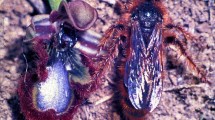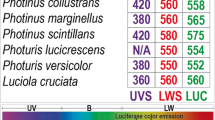Summary
The evolutionary tuning between floral colouration and the colour vision of flower-visiting Hymenoptera is quantified by evaluating the informational transfer from the signalling flower to the perceiving pollinator. The analysis of 180 spectral reflection spectra of angiosperm blossoms reveals that sharp steps occur precisely at those wavelengths where the pollinators are most sensitive to spectral differences. Straight-forward model calculations determine the optimal set of 3 spectral photoreceptor types for discrimination of floral colour signals on the basis of perceptual difference values. The results show good agreement with the sets of photoreceptors characterized electrophysiologically in 40 species of Hymenoptera.
Similar content being viewed by others
References
Backhaus W (1991) Colour opponent coding in the visual system of the honeybee. Vision Res 31:1381–1397
Backhaus W, Menzel R (1987) Color distance derived from a receptor model of color vision in the honeybee. Biol Cybern 55:321–331
Backhaus W, Menzel R, Kreißl S (1987) Multidimensional scaling of color similarity in bees. Biol Cybern 56:293–304
Burkhardt D (1983) Wavelength perception and color vision. In: Cosens DJ, Vince-Price D (eds) The biology of photoreception. Soc Exp Biol Symp 36:371–397
Chittka L (1992) The colour hexagon: a chromaticity diagram based on photoreceptor excitations as a generalized representation of colour opponency. J Comp Physiol A 170:533–543
Chittka L, Lunau K (1992) Colour coding and innate preferences for flower color patterns in bumblebees. In: Elsner N, Richter DW (ed) Rhythmogenesis in neurons and networks. Proc 20th Göttingen neurobiology conf 1992. Thieme, Stuttgart, p 298
Chittka L, Beier W, Hertel H, Steinmann E, Menzel R (1992) Opponent colour coding is a universal strategy to evaluate the photoreceptor signals in Hymenoptera. J Comp Physiol A 170:545–563
Clements FE, Long FL (1923) Experimental pollination: an outline of the ecology of flowers and insects. Carnegie Inst Wash Publ 336
Darwin C (1876) On the effects of cross and self fertilization in the vegetable kingdom. Murray, London
Daumer K (1956) Reizmetrische Untersuchungen des Farbensehens der Bienen. Z Vergl Physiol 38:413–478
Dukas R, Real L (1991) Learning foraging tasks by bees: a comparison between social and solitary species. Anim Behav 42:269–276
Dukas R, Shmida A (in press) Interactions of pollinating insects with flowers in a Mediterranean community. Oecologia
Faegri K, van der Pijl L (1978) The principles of pollination ecology. Pergamon Press, Oxford
Feinsinger P (1983) Co-evolution and pollination. In: Futuyma DJ, Slatkin M (eds) Co-evolution. Sinauer, Sunderland, Mass., pp 282–310
Free JB (1963) The flower constancy of honeybees. J Anim Ecol 32:119–131
Free JB (1966) The foraging behaviour of bees and its effect on the isolation and speciation of plants. In: Hawkes JG (ed) Reproductive biology and taxonomy of vascular plants. Pergamon, Oxford, pp 76–91
Frisch K von (1914) Demonstration von Versuchen zum Nachweis des Farbensinnes bei angeblich total farbenblinden Tieren. Verh Dtsch Zool Ges in Freiburg. Berlin
Frisch K von (1919) Über den Geruchssinn der Bienen und seine blütenbiologische Bedeutung. Zool Jb Physiol 37:1–238
Frisch K von (1967) The dance language and orientation of bees. Cambridge: Harvard Univ Press
Goldsmith TS (1991) The evolution of visual pigments and colour vision. In: Gouras P (ed) The perception of colour. London, MacMillan Press, pp 62–89
Gottsberger G, Gottlieb OR (1980) Blue flowers and phylogeny. Revta Bras Bot 3:79–83
Gottsberger G, Gottlieb OR (1981) Blue flower pigmentation and evolutionary advancement. Biochem Syst Ecol 9:13–18
Grant V (1950) The flower constancy of bees. Bot Rev 16:379–398
Gribakin FG (1988) Photoreceptor optics of the honeybee and its eye colour mutants: the effects of screening pigments on the long-wave subsystem of colour vision. J Comp Physiol A 164:123–140
Heinrich B (1979) “Majoring” and “minoring” by foraging bumblebees, Bombus vagans: an experimental analysis. Ecology 60:245–255
Helversen O von (1972) Zur spektralen Unterschiedlichkeitsempfindlichkeit der Honigbiene. J Comp Physiol 80:439–472
Kamil AC, Roitblat HL (1985) The ecology of foraging behavior: implications for animal learning and memory. Annu Rev Psychol 36:141–169
Kevan PG (1978) In: Richards AJ (ed) The pollination of flowers by insects. Linnean Soc Sympos Series 51
Kevan PG, Baker HG (1983) Insects as flower visitors and pollinators. Annu Rev Entomol 28:407–453
Koehler DL, Davenport D (1983) Ultraviolet mimicry by Bulbophyllum lepidum? Am Orchid Soc Bul 52:359–363
Kries J von (1905) Die Gesichtsempfindungen. In: Nagel W (ed) Handbuch der Physiologie des Menschen, Vol. 3. Braunschweig, Vieweg, pp 109–282
Laughlin SB (1981) Neural principles in the peripheral visual system of invertebrates. In: Autrum HJ (ed) Invertebrate visual centers and behaviour 1 (Handbook of sensory physiology, Vol VII/6B) Springer, Berlin Heidelberg New York, pp 133–280
Lipetz LE (1971) The relation of physiological and psychological aspects of sensory intensity. In: Loewenstein WR (ed) Principles of receptor physiology (Handbook of sensory physiology, vol I) Springer, Berlin Heidelberg New York, pp 191–225
Lythgoe JN (1972) The adaptation of visual pigments to the photic environment. In: Dartnall HJ (ed) Photochemistry of vision (Handbook of sensory physiology, vol VII/1). Springer, Berlin Heidelberg New York, pp 567–624
Lythgoe JN (1979) The ecology of vision. Oxford, Clarendon Press
Lythgoe JN, Partridge JC (1989) Visual pigments and the acquisition of visual information. J Exp Biol 146:1–20
Maximov VV (1988) An approximation of visual absorption spectra. Sensory systems (Sensornye systemy) 2:3–8
Mazokhin-Porshniakov GA (1962) Farbmetrischer Beweis der Trichromasie des Farbensehens der Bienen (am Beispiel der Hummeln). Akad Nauk USSR Biofizika 7:221–227
Menzel R (1967) Untersuchungen zum Erlernen von Spektralfarben durch die Honigbiene, Apis mellifica. Z Vergl Physiol 56:22–62
Menzel R (1979) Spectral sensitivity and colour vision in invertebrates. In: Autrum H (ed) Invertebrate photoreceptors (Handbook of sensory physiology, vol. VII/6A). Springer, Berlin Heidelberg New York, pp 503–580
Menzel R (1985) Learning in honeybees in an ecological and behavioural context. In: Hölldobler B, Lindauer M (eds) Experimental behavioural ecology. G Fischer, Stuttgart, pp 55–74
Menzel R, Backhaus W (1991) Color vision in insects. In: Gouras P (ed) Vision and visual dysfunction, vol. VI. The perception of colour. Houndsmills: MacMillan Press, pp 262–293
Menzel R, Shmida A (in press) The ecology of flower colours and the natural colour vision of insect pollinators. The Israeli flora as study case. Biol Rev
Menzel R, Ventura DF, Hertel H, de Souza J, Greggers U (1986) Spectral sensitivity of photoreceptors in insect compound eyes: comparison of species and methods. J Comp Physiol A 158:165–177
Nilsson LA (1983) Mimesis of bellflower (Campanula) by the red helleborine orchid Cephalanthera rubra. Nature 305:799–800
Peitsch D, Fietz A, Hertel H, de Souza J, Ventura DF, Menzel R (1992) The spectral input systems of hymenopteran insects and their receptor-based colour vision. J Comp Physiol A 170:23–40
Plateau F (1901) Observacion sur le phénomène de la constance chez quelques hyménoptères. Ann Soc Entomol Belg 45:56–83
Proctor M (1973) The pollination of flowers. Collins, London
Pyke GH, Pulliam HR and Charnov EL (1977) Optimal foraging: A selective review of theory and tests. Q Rev Biol 52:137–154
Rathke B (1983) Competition and facilitation among plants for pollination. In: Real LA (ed) Pollination biology. Academic Press, New York, pp 375–393
Selten R, Shmida A (1988) Pollinator foraging and flower competition in a game equilibrium model. Game Theory Behav Sci 18:3–67
Snyder AW, Menzel R, Laughlin SB (1973) Structure and function of the fused rhabdom. J Comp Physiol 87:99–135
Sprengel CK (1793) Das entdeckte Geheimnis der Natur in Bau und Befruchtung der Blumen. Reprint: Verlag J. Cramer, Lehre 1972
Stavenga DG (1989) Pigments in compound eyes. In: Stavenga DG, Hardie RC (eds) Facets of vision. Springer, Berlin Heidelberg New York, pp 152–172
Stavenga DG, Schwemer J (1984) Visual pigments of invertebrates. In: Ali MA (ed) Photoreception and vision in invertebrates. Plenum, New York, pp 11–61
Stephens WS, Krebs JR (1986) Foraging theory. Princeton University Press
Waser NM (1983) The adaptive nature of floral traits: ideas and evidence. In: Real LA (ed) Pollination biology. Academic Press, New York, pp 241–285
Waser NM (1986) Flower constancy: definition, cause, and measurement. Am Nat 127:593–603
Author information
Authors and Affiliations
Rights and permissions
About this article
Cite this article
Chittka, L., Menzel, R. The evolutionary adaptation of flower colours and the insect pollinators' colour vision. J Comp Physiol A 171, 171–181 (1992). https://doi.org/10.1007/BF00188925
Accepted:
Issue Date:
DOI: https://doi.org/10.1007/BF00188925




